Happy Birthday, Aurora! 120 years since the beginning of the construction of the cruiser
Yes, few ships in stories humanity can boast of such a period of its existence. And the more existence as a ship. Even if the ship-museum.
The value of the Aurora is huge, given the fact that we have only 10 real ships and one remark in the status of museum ships. And Aurora is also one of the oldest. Next to him you can put the world's oldest icebreaker museum "Angara", which stands in Irkutsk. They are the same age.
And the matter is not even in the political component, which allowed Aurora to live for so many years. It is great that that night the cruiser's gun babahnul single, thanks to this not very special and remarkable fact we have at our disposal a cruiser who has plowed more than one war. Wonderful.
So, "Aurora".
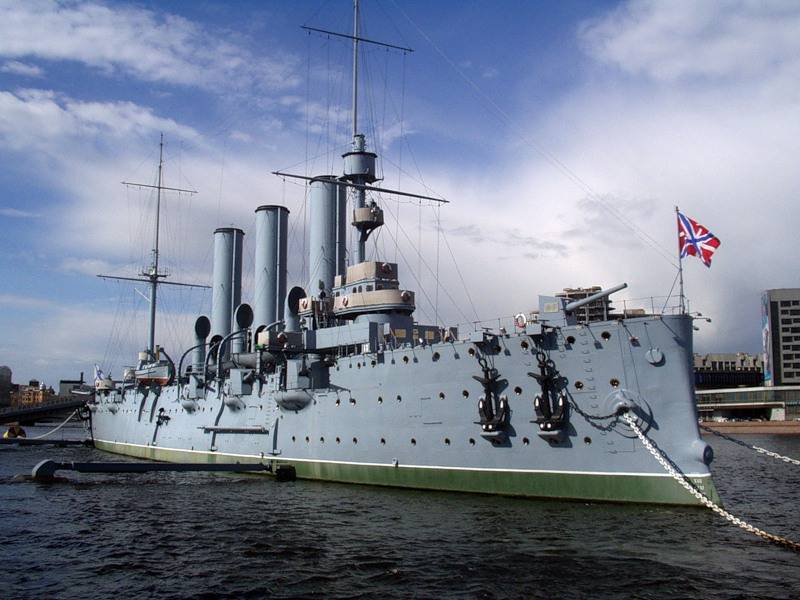
The cruiser "Aurora", like other ships of its type ("Diana" and "Pallas"), was built on the shipbuilding program 1895, in order to "equate our naval forces with the German and with the states adjacent to the Baltic states."
Diana-type cruisers became one of the first Russian armored cruisers, the design of which took into account, first of all, the experience of foreign countries. Nevertheless, for its time (in particular, during the Russian-Japanese war), ships of this type turned out to be ineffective due to the "backwardness" of many tactical and technical elements (speed, armament, booking).
The 1895 shipbuilding program assumed construction from 1896 to 1905. 36 new ships, among them nine cruisers, two of them (then - three) - "karapasnyh", that is, armored. Subsequently, these three armored cruisers became the Diana type.
The basis for the development of future cruisers was the design of the cruiser 6000 tons of displacement created by S.C. Warrior, the prototype of which was the newest (launched in 1895) English cruiser HMS Talbot and French armored cruiser D'Entrecasteaux (1896).
At the beginning of June 1896, the planned series was expanded to three ships, the third of which (the future Aurora) was ordered to be laid in the New Admiralty. 20 April 1896 Maritime Technical Committee (MTC) approved the technical design of the I class armored cruiser.
31 March 1897, Emperor Nicholas II ordered to call the cruiser under construction “Aurora” in honor of the sailing frigate “Aurora”, famous for the defense of Petropavlovsk-Kamchatsky during the Crimean War.
Despite the fact that the work on the construction of the Aurora was actually started much later than the Diana and Pallas, the official bookmark of cruisers of this type took place on one day: 23 in May 1897 in the old style. In a new style, it will be 4 Jun. This day can be considered the birthday of the ship.
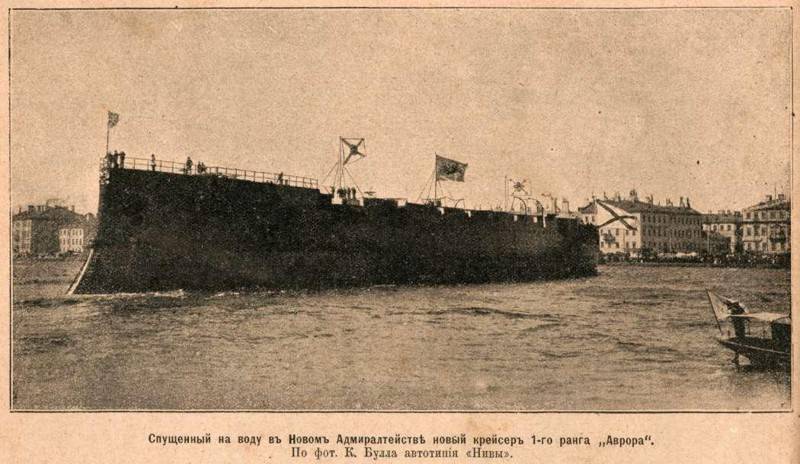
The stacking works were started in the fall of 1897, and they dragged on for three and a half years (largely due to the unreadiness of individual elements of the ship). Finally, on May 24, the 1900 Corps was launched in the presence of Emperor Nicholas II and Empresses Maria Feodorovna and Alexandra Feodorovna.
Following this, the installation of the main machines, auxiliary mechanisms, general ship systems, weapons and other equipment began. In 1902, for the first time in Russian navy The Aurora received Hall system anchors, a novelty that the other two ships of this type did not have time to equip. In the summer of 1900, the cruiser passed the first tests, the last on June 14, 1903.
The Aurora’s hull has three decks: the upper one and two internal ones (battery and armored), and also a tank superstructure. On the entire perimeter of the armor deck, which was called residential, is a platform, two more - on the ends of the ship.
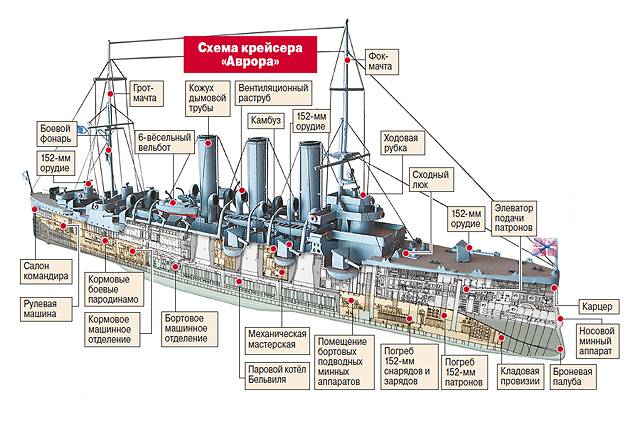
The main transverse bulkheads (below the armor deck) divide the interior of the hold into thirteen compartments. Four compartments (bow, boiler rooms, engine rooms, aft) occupy the space between the armored and battery decks and provide the ship’s unsinkability.
The outer steel plating had a thickness of up to 16 mm and was attached to the set with two rows of rivets. In the underwater part of the hull, the steel sheets were fastened in the bottom, while in the surface part, they were fastened on the back plates. The thickness of the sheeting of the bulwarks reached 3 mm.
The underwater part of the hull and its surface part on the 840 mm above the waterline had a millimeter copper lining, which, to avoid electrochemical corrosion and fouling, was attached to a wooden ticked panel fixed to the hull with bronze bolts.
On the cruiser there were two masts, the bases of which were attached to the armored deck. Foremast height - 23,8 m; main mast - 21,6 m.
The boiler plant consisted of 24 boilers of the Belleville system of the 1894 model, which were located in three compartments (fore, aft and middle boiler). On the sides of the cruiser were laid pipes of the main steam line to the main steam engines. Auxiliary boilers "Aurora", like other ships of the type, did not have. In view of this, steam was supplied to the auxiliary mechanisms through the steam line from the main boilers.
Above all three boiler houses there was a chimney 27,4 m in height. To ensure the operation of the boilers in the ship tanks 332 t of fresh water was contained (for the crew’s needs - 135 t), which could be replenished with the help of desalination systems of the circle, the total productivity of which reached 60 tons of water per day.
To place the coal on the Aurora, there were 24 coal pits located in the inter-air space at the boiler houses, as well as 8 coal pits of spare fuel located between the armored and battery decks throughout the engine rooms. These 32 pits could hold up to 965 tons of coal. 800 tons of coal were considered as normal fuel reserves. A full supply of coal could be enough for 4000 miles of navigation at speeds of 10 knots.
The main engines were three triple-expansion steam engines (total power - 11600 hp). They should have been able to provide 20-node speed (during the tests, the Aurora reached the maximum speed in 19,2 knots, which generally exceeded the maximum speed of the Diana and Pallas in the tests).
Cruiser propulsion - three three-blade bronze propellers. The middle screw was a screw of the left rotation, the right one rotated counterclockwise, the left one - clockwise (view from the stern to the bow).
The living quarters were calculated on the 570 man crew (20 officers and 550 conductors and lower ranks) and on the placement of the flagship of the compound with its headquarters. The lower ranks slept on hanging beds located in the bow of the ship, 10 conductors were located in five double cabins on the armor deck, officers and admirals - in rooms in the stern of the ship. The food supply was calculated for two months.
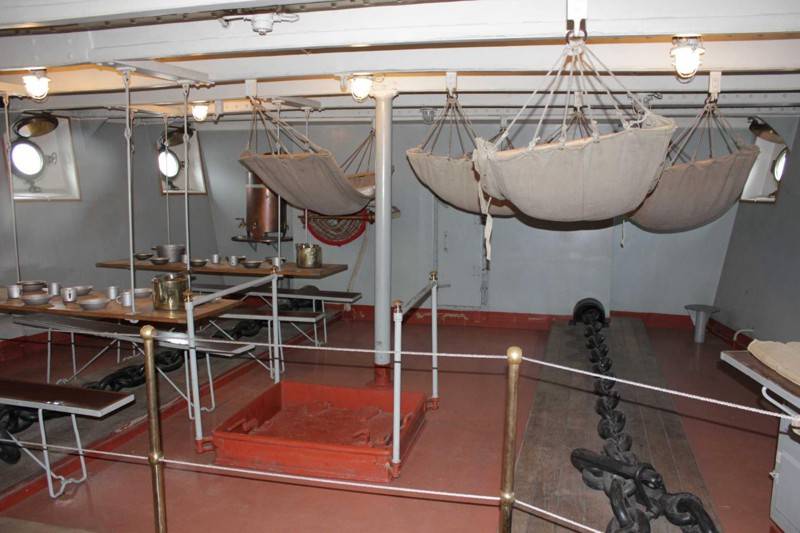
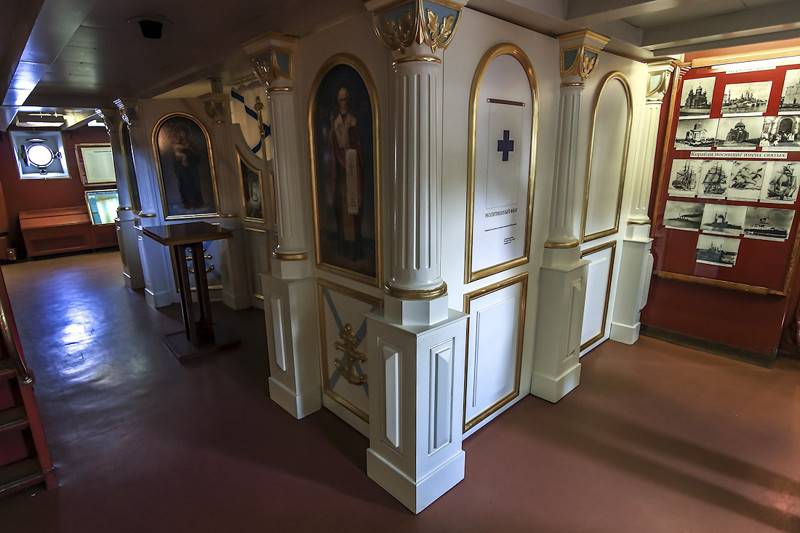
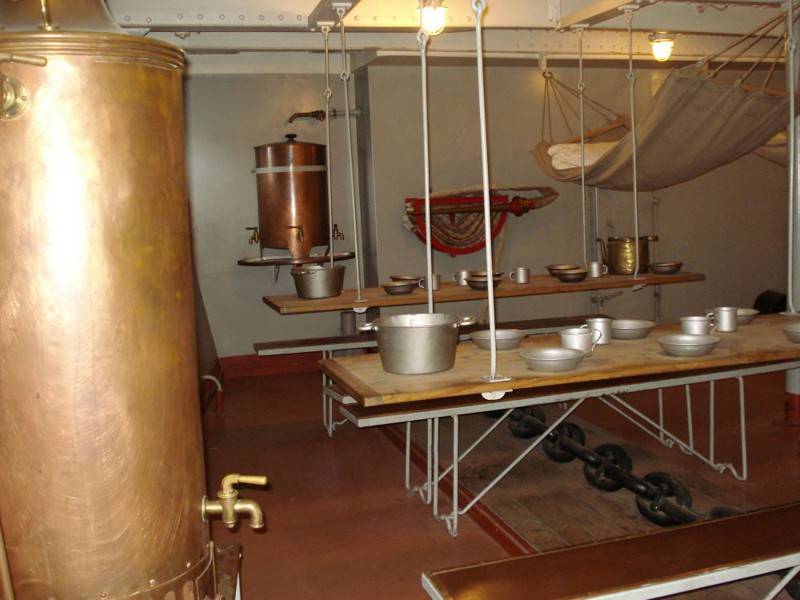
The Aurora’s artillery was made up of eight 152-mm with a barrel length 45 of Cana’s system calibers, placed one on the forecastle and a canteen and six on the upper deck (three on each side). The maximum range of the gun to 9800 m, the rate of fire - 5 rounds per minute with mechanical projectile feed and 2 round - with manual. The total ammunition consisted of 1414 shots. The shells in their action were divided into armor-piercing, high-explosive and shrapnel.
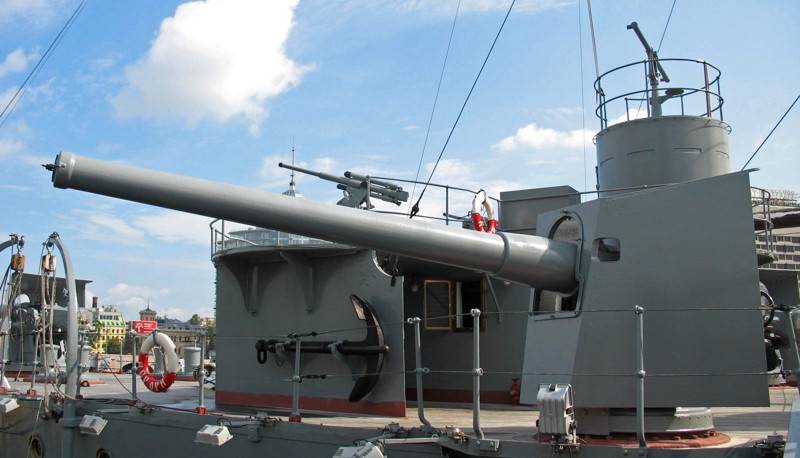
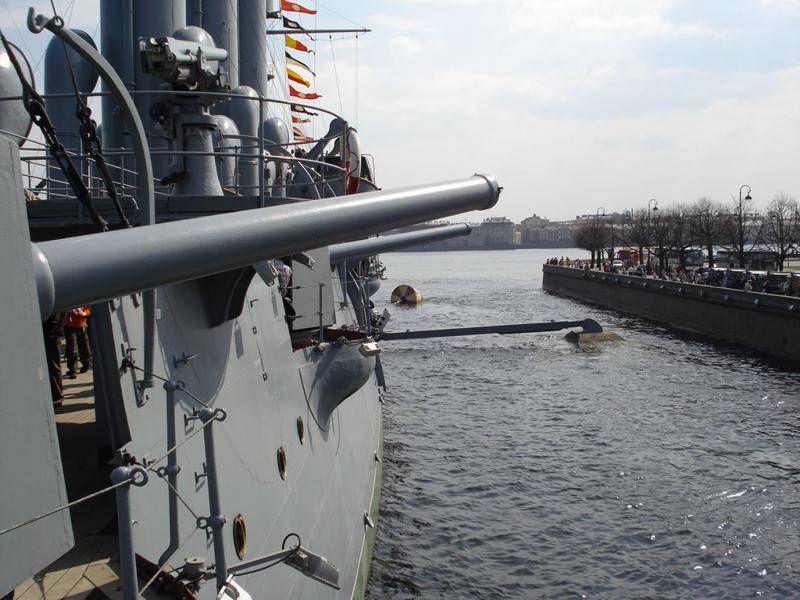
On the upper and battery decks, twenty-four 75-mm were installed with 50 barrel lengths of Kane system guns on vertical Möller system machines. Firing range - up to 7000 m, firing rate - 10 shots per minute with mechanical feed and 4 - with manual feed. Their ammunition totaled armor-piercing 6240 cartridges.
8 single Hotchkiss 37-mm guns and two Baranovsky 63,5-guns of the Baranovsky system were installed on Mars and the bridges. For these guns, respectively, there were 3600 and 1440 cartridges.
Mine warheads included one surface retractable torpedo tube, firing torpedoes through a stem apple, and two submersible traverse shield devices, mounted side by side.
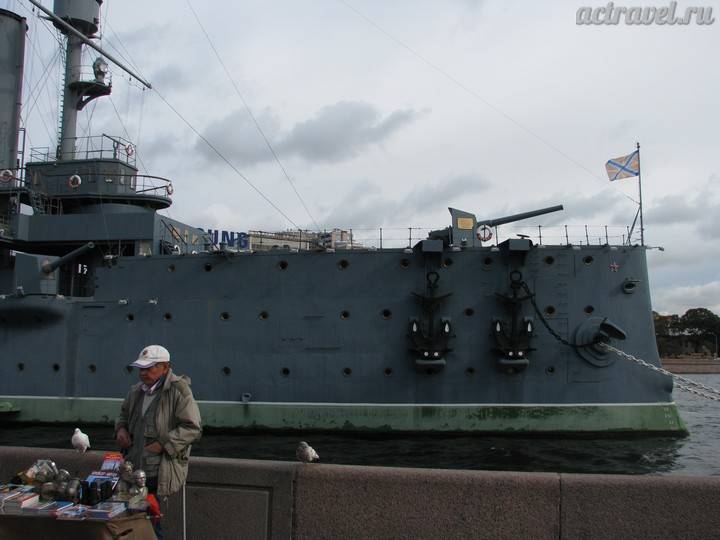
The rounded thickening in the nose just above the green line - this is the nasal torpedo tube.
The shooting of Whitehead torpedoes was done with compressed air at a ship’s speed up to 17 knots. Torpedo tubes firing was carried out with the help of three sights (one for each vehicle) located in the conning tower. The ammunition was eight torpedoes with a caliber of 381 mm and a range of 1500 m. Two of them were stored at the nose, and another six - in the department of underwater vehicles.
The mine armament also included 35 spheroconical barrage mines, which could be installed from rafts or boats and craft boats. On the sides of the Aurora, anti-mine networks of an obstacle were hung out on special tubular poles if the cruiser was anchored in an open roadstead.
The external communication of the ship was provided by signal flags, and also (rarely) by Manjen's “flashlights” - searchlights with 75 mirror diameter, see. The main purpose of the latter was to illuminate the enemy destroyers in the dark. "Aurora" was armed with six searchlights.
For the night distant visual alarm on the cruiser there were two sets of lights of the system of Colonel V.V. Tabulevich. This means, new for that time, consisted of two lamps of red and white colors.
To enhance the intensity of the lights, a special combustible powder was used, which, under favorable meteorological conditions, made it possible to see the lights at a distance of 10 miles. Signaling was carried out by transmitting numbers in Morse code: the dot was indicated by a flash of a white lantern, and a dash - by red.
Observation was carried out using telescopes and binoculars.
The cruiser artillery fire control system allowed the artillery officer to control the entire artillery of the ship and each weapon separately. The distance to the target was measured using the Barra and Stroud system range finder in England.
The prolonged sea trials allowed the Aurora to make its first access to the sea only on September 25. Cruiser was sent to the Far East along the Portland - Algeria - La Spezia - Bizerte - Piraeus - Port Said - Suez port route. Having reached Djibouti at the end of January 1903, the connection of Rear Admiral A.A. Virenius learned of the beginning of the war with Japan and went back to the Baltic, where 1904 arrived in April.
After returning to the Baltic Sea, the Aurora was included in the 2-nd squadron of the Pacific Fleet, which was to leave for Vladivostok as soon as possible, in order, first, to help the Pacific Navy squadron, and, second, to break Japanese fleet and establish dominance in the Sea of Japan. The cruiser arrived under the command of Vice-Admiral Z. P. Rozhestvensky, and on October 1 2 left Libauu as part of his unit, thus starting a long transition to the Pacific Ocean.
October 7 cruiser and its connection almost reached the shores of Great Britain, which was a political opponent of Russia in the fight against Japan and the ally of the latter - so Z. P. Rozhestvensky ordered to bring all ships on high alert. In the Dogger Banks area, a compound found unidentified vessels (which turned out to be British fishing vessels) and shelled them. Moreover, the Aurora and Dmitry Donskoy also came under fire from the battleships. This so-called Gull incident eventually caused a major international scandal and led to a peak in the deterioration of relations between Russia and Great Britain.
And Aurora suffered its first losses. The cruiser "Aurora" got 5 shells fired by Russian ships, which was seriously wounded by the ship's hieromonk Anastasia Rukin (his hand was torn off, in October 1904, he died in the Tangier hospital) and easily - the commander.
By 1 in May 1905 the squadron of Rozhestvensky reached Van-Fong Bay, from where it left for the last passage to Vladivostok. On the night of May 14, the 50 warships of the compound entered the Straits of Korea, where the Tsushima battle took place several hours later.
In the course of this battle, the Aurora acted in the composition of the Cruising Detachment of Rear Admiral O. A. Enquist. Because of the chosen Rozhestvensky construction of the Aurora ships, like the other cruisers of their unit, in the first 45 mines of the battle (from 13 h. 45 min. To 14 h. 30 min.) Did not participate.
K 14 h. 30 min. nine Japanese cruisers chose the transport ships of the Russian squadron as their targets, and the Aurora, together with the flagship cruiser Oleg, engaged them in battle. As far as possible, they were also helped by “Vladimir Monomakh”, “Dmitry Donskoy” and “Svetlana”.
However, the defeat of the Russian squadron was already inevitable. With the onset of the night of 15 in May, the scattered ships of the Russian squadron made separate attempts to break through to Vladivostok. So, "Aurora", "Oleg" and "Pearls" made such attempts, but unsuccessfully. Dodging torpedo attacks by Japanese destroyers, these ships received an order from O. A. Enquist to turn south, thereby leaving the battle zone and the Korean Strait.
By May 21, these three cruisers, with nearly completed fuel supplies, were able to reach the Philippine Islands, where they were interned by Americans in the port of Manila. During the battle of Tsushima "Aurora" was seriously damaged; 10 crew man was killed, another 80 - injured. The only officer of the cruiser who died in battle was his commander, captain of the 1 rank, E. G. Egorev.
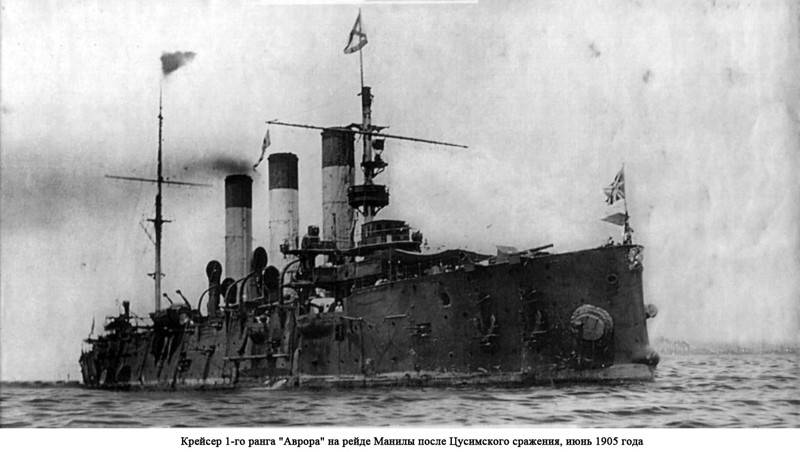
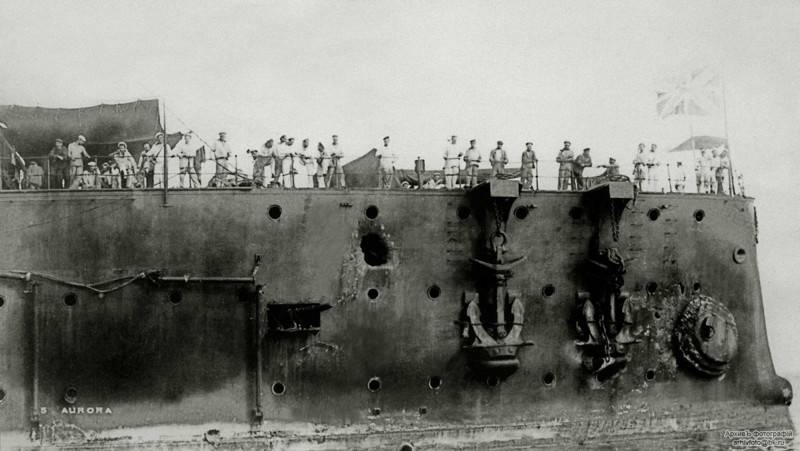
Being in Manila for four months, the crew of the Aurora on its own carried out repair and restoration work.
10 October 1905 g., Having received a message about the end of the war with Japan, the St. Andrew’s flag and huys were raised again on the cruiser. The Americans returned the previously handed over locks.
Having received an order to return to the Baltic Sea, the Aurora reached Libava 19 February 1906. The state of the ship was examined there. After that, the forces of the Franco-Russian, Obukhov factories and the Kronstadt military port underwent repair of the cruiser and its artillery weapons. Already in 1907 - 1908. "Aurora" was able to take part in the training voyages.
It is noteworthy that domestic naval designers back in 1906, that is, when the Aurora only returned to Libau, appreciated the new quality level of shipbuilding in other countries.
When in September 1907 a new classification of ships of the Russian fleet was introduced, according to it (cruisers were now subdivided into armored cruisers and cruisers, and not by rank and depending on the booking system) the Aurora, as well as the Diana, was related to cruisers.
In 1909, the “Diana” (flagship), “Aurora” and “Bogatyr” were included in the “Squadron of ships designated for navigation with ship midshipmen”, and after the highest review by Nicholas II, 1 October 1909 went to the Mediterranean, in the waters of which were until March 1910.
During this time, many different exercises and exercises were conducted. 1911 - 1913 "Aurora" remained a training ship, having made long voyages to Thailand, on about. Java.
In July 1914, the First World War began. In the middle of August, almost after a ten-year break, the Aurora was included in the composition of warships, it was enlisted in the 2 Brigade of cruisers. All ships of this brigade were built before the Russian-Japanese war, so the command sought to use them only as a guard service.
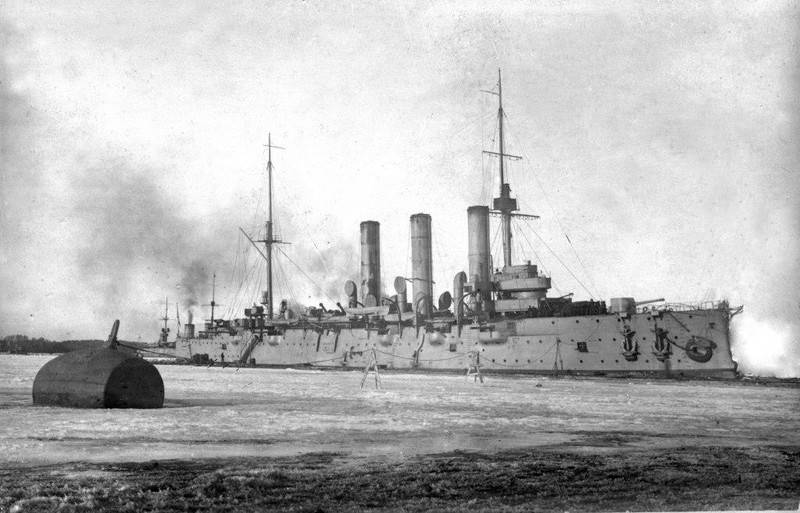
In November-December, 1914 “Aurora” surveyed the fairways leading from the Gulf of Finland to the Gulf of Bothnia. Winter "Aurora" and "Diana", which was also included in the composition of this compound, held in Sveaborg, where during this time there have been some modernization. Then - again sentinel and skerny service.
Only during the 1916 campaign, the Aurora had the opportunity to participate directly in hostilities. At this time, the cruiser was at the disposal of the command of the Marine Corps, where she passed the ship control exams. During this year, the 75-mm guns of the cruiser were re-equipped in such a way as to be able to fire at low-flying low-speed aircraft, which was enough for successful shooting at aircraft of the First World War. So, being in the Gulf of Riga "Aurora" successfully repelled attacks from the air.
But the ship needed to be repaired, so 6 September 1916 of the Aurora arrived in Kronstadt. In September she was transferred to Petrograd to the extension wall of the Admiralty Plant.
During the repair, the second bottom in the area of the boiler room was replaced, the cruiser received new boilers and repaired steam engines. The cruiser armament was also upgraded: the maximum elevation angle of 152-mm guns and, accordingly, the maximum firing range were increased. Spaces for the installation of three 76,2-mm anti-aircraft guns of the F. F. Lender system were prepared, which, however, were installed only in 1923.
27 February 1917 in the Admiralteisky and Franco-Russian plants, which were repaired, a strike began. The commander of the Aurora M. I. Nikolsky, wanting to prevent a riot on the ship, opened fire from a revolver on the sailors who tried to go ashore, for which he was finally shot dead by an insurgent team. From that moment on, the ship’s commanders were elected by the ship’s committee.
From 24 in October 1917, the Aurora took part directly in revolutionary events: on the orders of the Provisional Revolutionary Committee (WRC), the cruiser went upstream on the Bolshaya Neva from the extension wall of the plant to the Nikolayevsky bridge, divorced by the junkers, forcing the latter to leave.
Then the Aurora electricians brought the openings of the bridge together, thereby connecting Vasilyevsky Island with the city center. The next day, all strategic objects of the city were in the hands of the Bolsheviks. By agreement with the secretary of the Revolutionary Military Committee V. A. Antonov-Ovseenko, the Aurora “shortly before the attack of the Winter Palace began, according to the signal shot, Peter and Paul Church will give a couple of single shots of six-inch shots.”
In 21 h. 40 min. a shot of the guns of the Peter and Paul Fortress followed, and five minutes later, the Aurora fired one blank shot from the nose 152-mm gun, which made it famous. However, the storming of the Winter Palace with this shot is not directly connected in any way, as it began later.
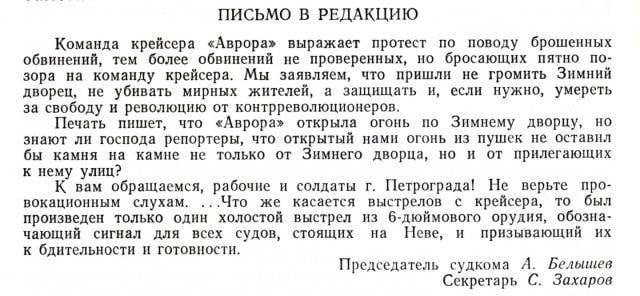
At the end of October, 1922 began the re-deployment of the cruiser, to be used as a training ship for the Baltic Fleet. On the 23 February holiday, 1923, despite the fact that the Aurora was still not technically ready, the flag and huys were raised on the cruiser.
In June 1923, the hull of the ship was significantly repaired, somewhat later it was reequipped, including the artillery cellars and elevators were redone. Thus, the Aurora received ten 130-mm guns (instead of 152-mm), two 76,2-mm anti-aircraft guns of the Lender system, two pairs of 7,62-mm Maxim machine guns. July 18 conducted sea trials, and in the fall the cruiser took part in the maneuvers of the ships of the Baltic Fleet.
But the canonization of Aurora began earlier. 3 August 1923 The Central Executive Committee, the supreme body of state power, took charge of the cruiser. This immediately raised the ship’s ideological-political status, elevating it to the rank of a symbol of revolution.
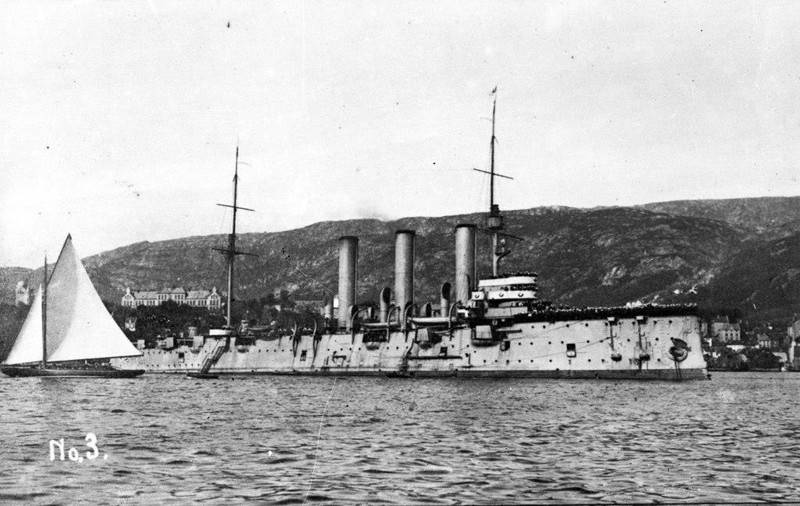
In 1924, the Aurora made its first long voyage under the Soviet flag: the cruiser rounded Scandinavia, reached Murmansk and Arkhangelsk. Up to 1927, the ship participated in various campaigns (mainly in the territorial waters of the USSR). 2 November 1927 in honor of the 10 anniversary of the revolution "Aurora" was awarded the only at that time state award - the Order of the Red Banner:
“... The Presidium, recalling sincere admiration in the days of the October Revolution 10 anniversary of the Aurora cruiser in the frontline positions of the revolution, awards him with the Order of the Red Banner for the differences he showed on the October Days.
(From the CEC resolution.) "
In the same year, the epic film “October” was shot, where Aurora took part in the filming. These two events made the cruiser even more famous.
With 1928, the cruiser again became a training ship and annually conducted training trips on board with cadets abroad. In particular, Aurora visited Copenhagen, Swinemünde, Oslo, Bergen.
A visit to Bergen in August of 1930 was for Aurora the last foreign campaign due to the deterioration of the boilers (a third of them were decommissioned). The cruiser needed a major overhaul, which he went to at the end of 1933.
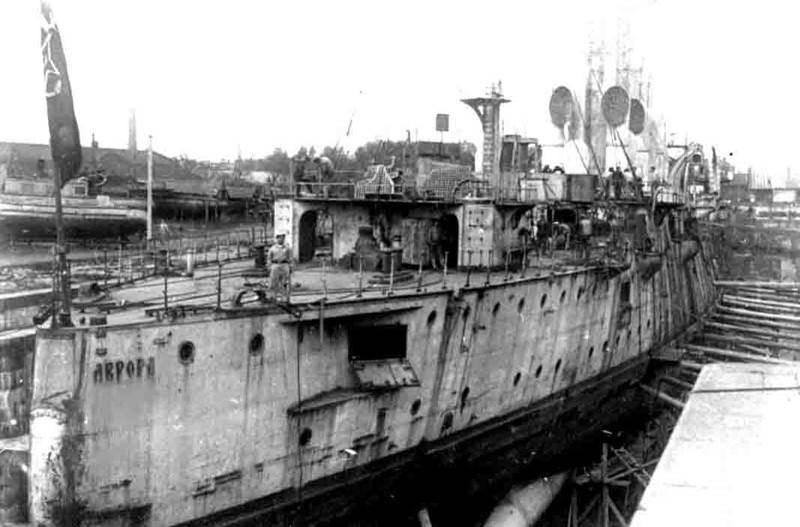
In 1935, for various reasons, including because it was inappropriate to repair a morally and technically obsolete ship, repairs were stopped. Now it has become dumb because of the fact that the workers of the plant. Marty did not have time to replace the boilers during the repair; the Aurora had to become a training team: it was taken to the East Kronstadt raid, where first-year cadets of naval schools were practicing.
According to some researchers, in 1941, the Aurora was planned to be excluded from the fleet, but this was prevented by the outbreak of the Great Patriotic War. When the threat of an exit of German troops to Leningrad was created, the cruiser was immediately included in the air defense system of Kronstadt. Back in June, the Aurora cadets went to the front, then began a gradual reduction of the crew of the cruiser (to the beginning of the war - 1941 people), which was distributed to the existing ships of the Baltic Fleet or to the front.
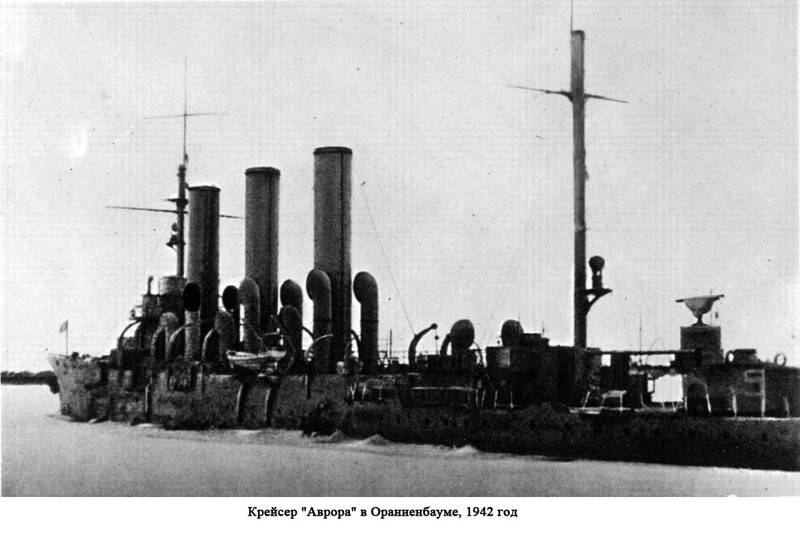
By the beginning of the war, the Aurora had ten 130-mm guns, four 76,2-and three 45-mm anti-aircraft guns and one Maxim machine gun. Since July, 1941 from the Aurora began to dismantle artillery armament and use it either on other ships (for example, in the canonies of the Peipsi Military Flotilla), or as part of land batteries.
9 July 1941. Of the nine 130-mm guns cruisers formed a special-purpose artillery battery. Of the guns found in the arsenals of Leningrad and Kronstadt, a second battery was soon formed, and both were transferred to the 42 Army of the Leningrad Front.
In the history of the defense of Leningrad, they are known as the battery "A" ("Aurora") and the battery "B" ("Baltiets" / "Bolshevik"). From the own crew of the Aurora in the personnel of the battery "A" was only a small number of fighters.
Battery "A" first opened fire on the advancing enemy on September 6, 1941. Then, during the week, the battery fought with the German tanksfighting in complete surroundings to the last shell. By the end of the eighth day of fighting, out of 165 personnel, only 26 had reached their own.
The cruiser Aurora itself took part in the hostilities near Leningrad 8 September 1941.
The crew remaining on the ship had to repel German attacks aviation, and on September 16, according to eyewitnesses, the Aurora anti-aircraft gunners managed to bring down one enemy aircraft. Moreover, the Aurora was constantly under artillery fire, which from time to time was carried out by German batteries until the final lifting of the blockade of Leningrad. In total, during the war, the cruiser received at least 7 hits. At the end of November, the living conditions on the cruiser became unbearable, and the crew was transferred ashore.
So, N. G. Kuznetsov, people's commissar of the USSR Navy, spoke out about Aurora’s modest, but still significant participation in the defense of Leningrad:
“The cruiser“ Aurora ”was not a serious combat value, but it did its best during the war years. The share of individual ships falls many years of service, even after they "lost" the original fighting qualities. Such is the cruiser "Aurora".
In the middle of 1944, it was decided to create the Leningrad Nakhimov Naval School. Part of the Nakhimovites was planned to be placed on a floating base, which the Aurora was supposed to become temporarily. However, by the decision of A. A. Zhdanov, the cruiser Aurora was to be permanently installed on the Neva, “as a monument to the active participation of the sailors of the Baltic Fleet in the overthrow of the bourgeois Provisional Government.” Immediately, work began on restoring the watertightness of the cruiser hull, which received numerous damages.
Over a three-year overhaul (from mid-July 1945 to mid-November 1948) were repaired: the hull, propellers, side-mounted steam engines, side-propeller shafts, shaft brackets of side-mounted machines, the remaining boilers. Also, a reorganization was carried out in connection with the new function of the ship-floating base.
This reorganization had a negative impact on the preservation of the historical appearance of the cruiser, as well as the alterations caused by filming. In 1947, Aurora played the role of Varyag in the eponymous film.
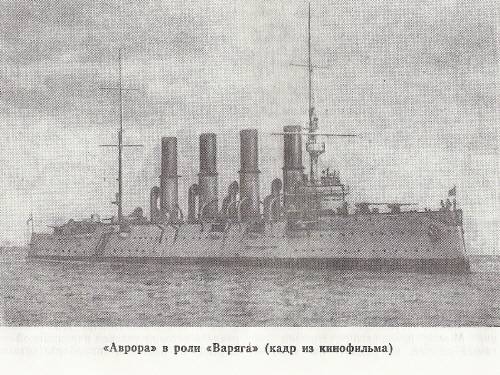
17 November 1948, the cruiser for the first time took its place on the eternal parking on the Bolshaya Nevka. Immediately on the "Aurora" was placed the final company Nakhimov. From that time until 1961, it became a tradition for Nakhimov graduates to live and serve on the Aurora.
By the Resolution of the RSFSR Council of Ministers No. 1327 of 30 in August 1960, the Aurora was given the official status of a memorial ship protected by the state. From 1961 to the museum that existed on the ship from 1950 on the initiative of several officers, free entry was opened, and its exposition was expanded. Soon the Aurora became one of the most popular places in the city.
The final canonization of the Aurora, turning it into a ship-symbol occurred in 1967, when, in honor of the 50 anniversary celebration of the 1917 revolution, the Aurora again made a single shot from the tank 152-mm gun exactly 21 h. 45 min.
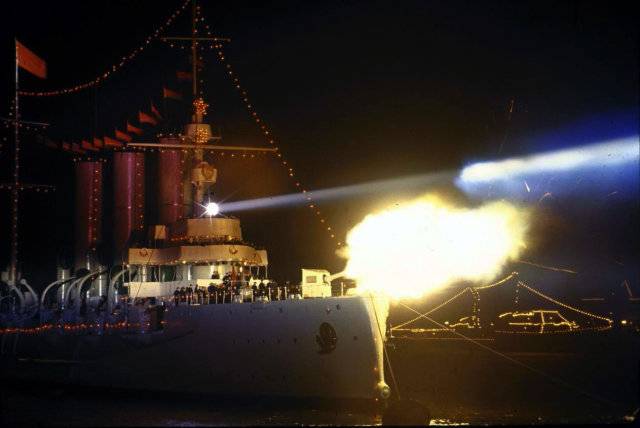
In February, the 1968 cruiser was awarded the second most important order in the country - the October Revolution. Thus, the Aurora, once having become the first order-bearing ship, became the first twice-order ship in the history of the Soviet Navy.
By the end of the 1970's, the Aurora's hull came in disrepair. Required repair reconstruction. After making proposals from a specially created commission, repairs began in August 1984 and lasted until August 1987.
Instead of a complete restoration, it was decided to replace the old building with a new one.
26 July 1992 on the Aurora St. Andrew’s flag was raised again, and the ship was already serving as part of the Russian Navy. 1 December 2010, the cruiser "Aurora" by order of the Minister of Defense of the Russian Federation was removed from the Navy and transferred to the balance of the Central Naval Museum.
The cruiser military crew was reorganized into a staff of three soldiers and 28 civilian personnel. Moreover, the Aurora retained the status of a warship.
September 21 The Aurora 2014 was towed to the overhaul of the Kronstadt Marine Plant of the Defense Ministry of the Russian Federation for overhaul.
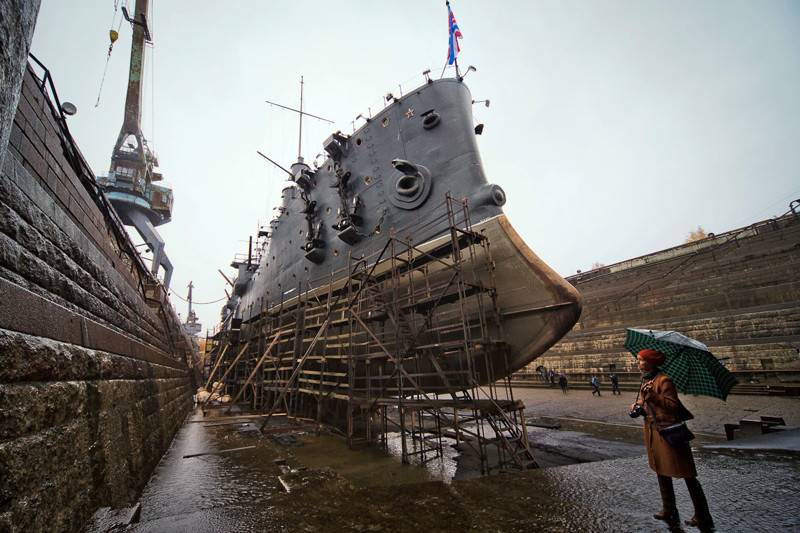
16 July, 2016, St. Petersburg was greeted by a cruiser who returned to his historic place after repairs.
This is the fate. Longer than the many not less deserved ships. Still, in that single woman 1917 of the year turned out to be a great sense. After years of 100, we still have a veteran ship that has gone through three wars.
God bless him, with a coup. Happy birthday, "Aurora"!
Sources:
http://wiki.wargaming.net/ru/Ship:Аврора
http://www.fontanka.ru
Skvortsov A.V. Cruiser I rank "Aurora", "Diana" and "Pallas".
Novikov V., Sergeev A. Goddess of the Russian fleet. "Aurora", "Diana", "Pallas".
Polenov L. L. Cruiser Aurora.
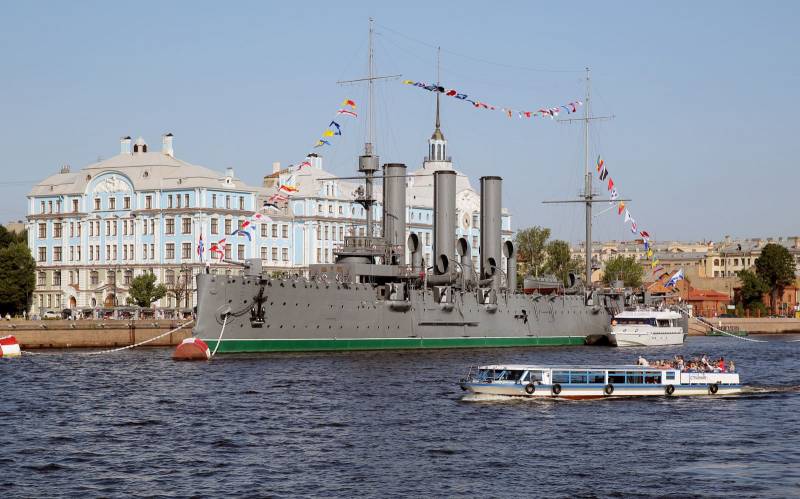
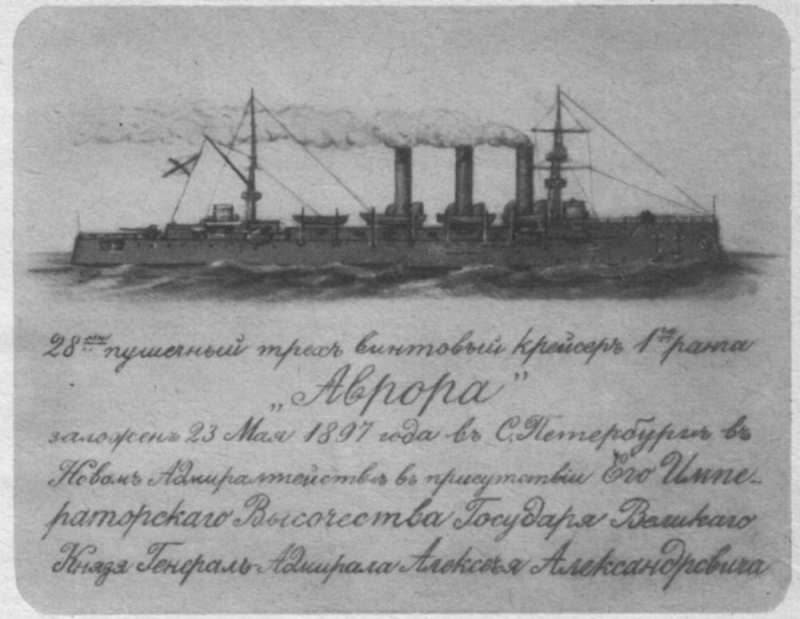
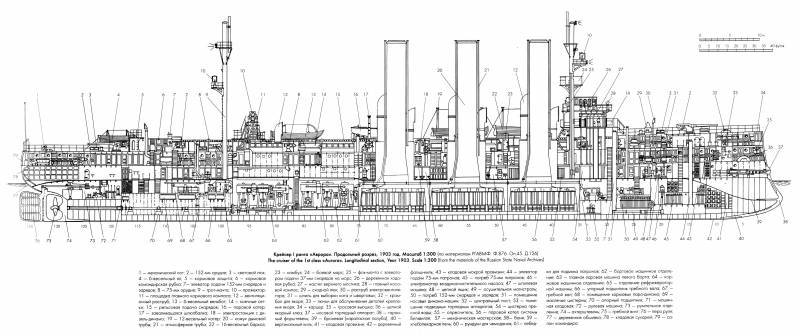
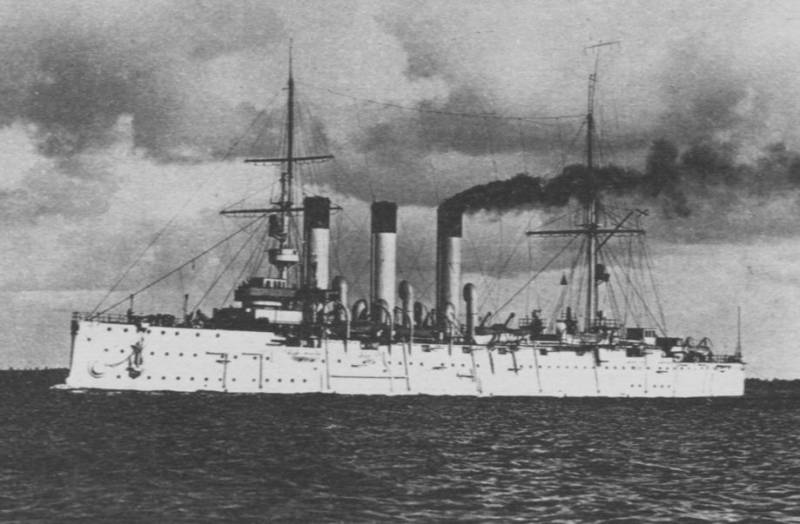
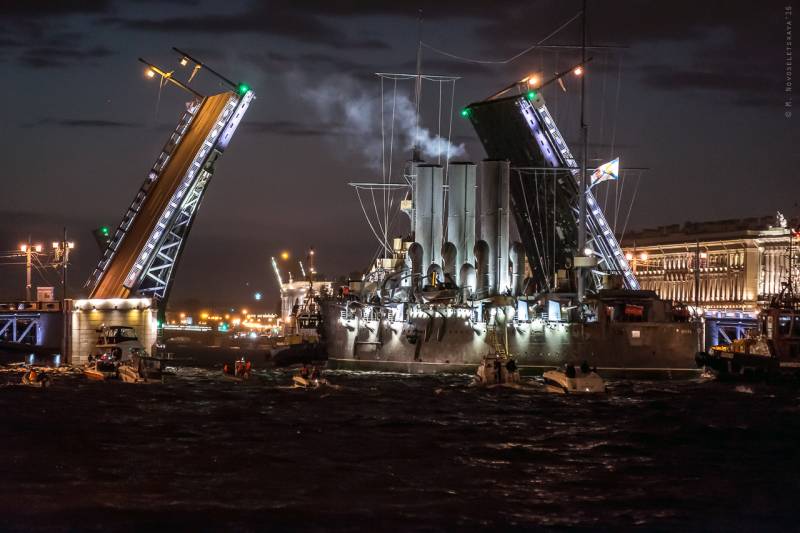
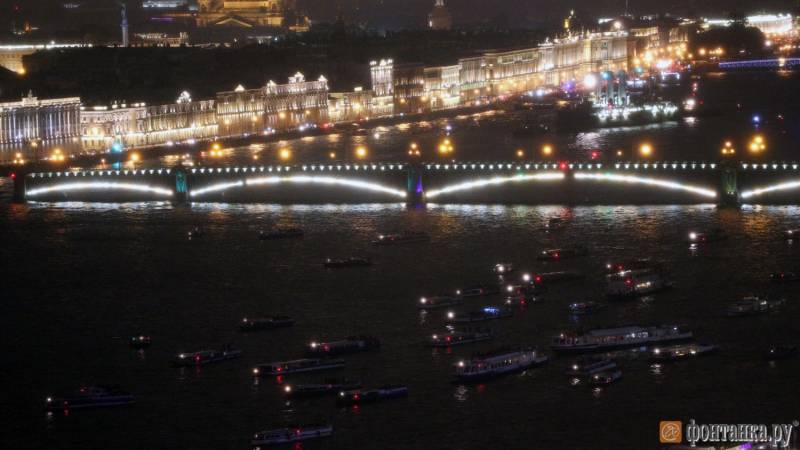
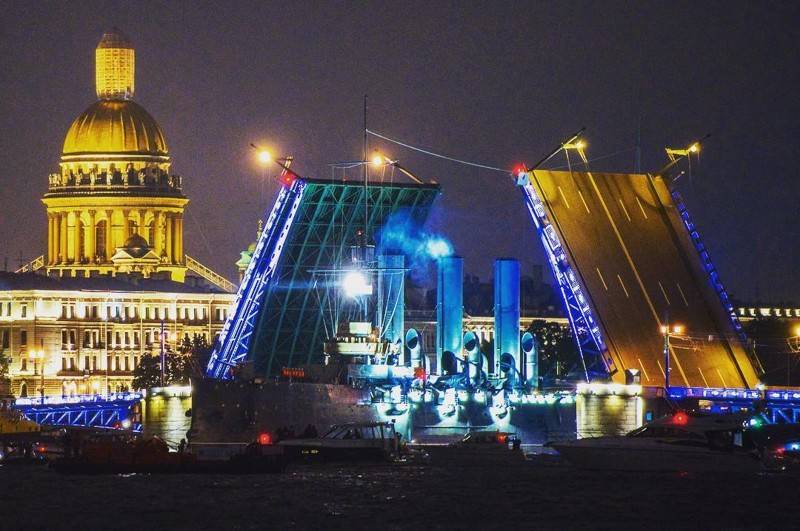
Information